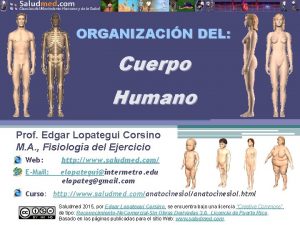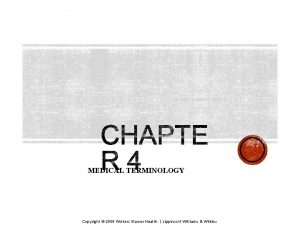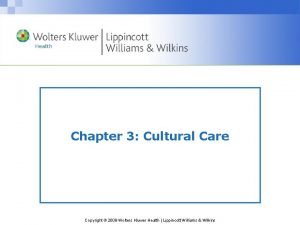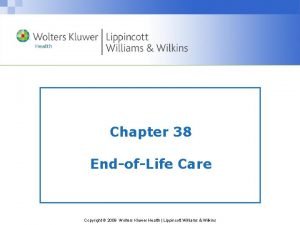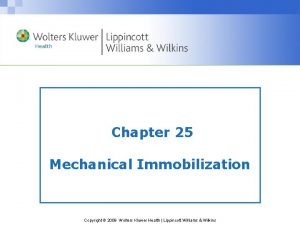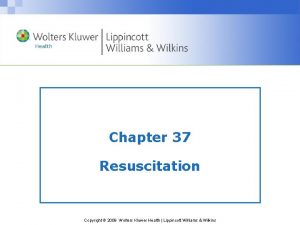Chapter 3 Cultural Care Copyright 2009 Wolters Kluwer




























- Slides: 28

Chapter 3: Cultural Care Copyright © 2009 Wolters Kluwer Health | Lippincott Williams & Wilkins

What Does Healthy People 2010 Say About Cultural Care? • Elimination of disparity among groups in access to quality health care • Increase in community-based programs that are culturally and linguistically appropriate Copyright © 2009 Wolters Kluwer Health | Lippincott Williams & Wilkins

Cultural Knowledge • Familiarity with a culturally or ethnically diverse group's world view, beliefs, values, practices, lifestyles, and problem-solving strategies Copyright © 2009 Wolters Kluwer Health | Lippincott Williams & Wilkins

Client Situations in Practice • John is home-visiting a family in the Hmong community in St. Paul, Minnesota. As he walks in the door of the home, a young boy is standing there, and John reaches out to touch his head in greeting, as an expression of caring. Copyright © 2009 Wolters Kluwer Health | Lippincott Williams & Wilkins

Lack of Cultural Knowledge… • The nurse is unaware of the strong taboo against touching the head, which is considered the most sacred part of the body. This unintentional affront compromises the nurse’s ability to provide culturally sensitive care to the family. Copyright © 2009 Wolters Kluwer Health | Lippincott Williams & Wilkins

Perspectives of Cultural Care • Emic: the local or insider’s views and values about a phenomenon • Etic: the professional or outsider’s views and values about a phenomenon Copyright © 2009 Wolters Kluwer Health | Lippincott Williams & Wilkins

Cultural Assessment • Communication • Space • Social organization • Time • Environmental control • Biologic variations Copyright © 2009 Wolters Kluwer Health | Lippincott Williams & Wilkins

Space and Physical Contact • How close people stand to each other in conversation, overt expressions of affection or caring with touch, and rules relating to personal space and privacy vary greatly among cultures. • Space or physical contact must be considered while providing or planning care. Copyright © 2009 Wolters Kluwer Health | Lippincott Williams & Wilkins

Question How can nurses know what the cultural norm is when the nurse’s culture is different from the client’s culture? A. The nurse must learn about the cultural norms of every cultural group in his or her community to always be able to predict client preference. B. The professional nurse learns about cultural traditions and beliefs by reading, observing, and asking questions. When in doubt, it is always appropriate to ask, “In your culture, what is considered proper relating to touching and physical space? ” C. It is impossible to predict cultural preferences related to space and privacy. Copyright © 2009 Wolters Kluwer Health | Lippincott Williams & Wilkins

Answer B. The professional nurse learns about these cultural traditions and beliefs by reading, observing, and asking questions. When in doubt, it is always appropriate to ask, “In your culture, what is considered proper relating to touching and physical space? ” However, it is important not to stereotype people and to always realize that there are often individual differences within cultural groups. When in doubt, it is important to ask clients or their families to state their preferences. Copyright © 2009 Wolters Kluwer Health | Lippincott Williams & Wilkins

Social Organizations • Areas the nurse considers, learns about, or assesses related to social organizations – Definition of family in the culture in question – Gender or age roles that affect communication patterns within the culture – Traditional roles within the family that impact caregiving – What value is placed on children and the elderly Copyright © 2009 Wolters Kluwer Health | Lippincott Williams & Wilkins

Biologic Variation • Biocultural variations may impact the health of cultures within your community. • Nurses can prepare to care for individuals with these conditions or risk factors (see Table 3 -3). Copyright © 2009 Wolters Kluwer Health | Lippincott Williams & Wilkins

Cultural Assessment • Cultural skill: the ability to collect relevant cultural data regarding the client’s health history (Campinha. Bacote) • Cultural assessment: ”systematic identification and documentation of culture care, beliefs, meanings, values, symbols, and practices of individuals or groups with a holistic perspective” (Leininger & Mc. Farland, 2002, p. 117) Copyright © 2009 Wolters Kluwer Health | Lippincott Williams & Wilkins

Assessment Tools (Heineken & Mc. Coy) • If the client is an immigrant or refugee, ask: – How is this kind of illness treated in your country? – How would you describe this problem you have? Or is there someone else I should talk to? – What does this sickness do to you? Copyright © 2009 Wolters Kluwer Health | Lippincott Williams & Wilkins

Heineken & Mc. Coy Assessment (cont’d) • How long have you had the problem? When has the problem happened to you? • Why do you think the problem began when it did? • What do you think is wrong, out of balance, or causing the problem? Copyright © 2009 Wolters Kluwer Health | Lippincott Williams & Wilkins

Heineken & Mc. Coy Assessment (cont’d) • What has been done so far? • What do you think will help your problem clear up? • What does your family think should be done? • Who else do you think can help you get better? • How serious do you think this problem is? (Heineken, J. , & Mc. Coy, N. [2000]. Establishing a bond with clients of different cultures. Home Healthcare Nurse, 18[1], 45– 51. ) Copyright © 2009 Wolters Kluwer Health | Lippincott Williams & Wilkins

Question Your client has lived in the U. S. for about 10 years. She is not taking her prescribed medications. You are perplexed because you thought that she understood the importance of taking the medications, so you decide to do a cultural assessment. What is the first question that you ask? A. What is your cultural background? B. How is this kind of illness treated in your country? C. How do you think that your cultural beliefs impact your perception of your illness? Copyright © 2009 Wolters Kluwer Health | Lippincott Williams & Wilkins

Answer B. How is this kind of illness treated in your country? Knowing the client’s cultural background may or may not provide helpful information. Nor will she necessarily be able to articulate how her cultural beliefs impact her illness. However, she will be able to talk about how her illness would be treated in her homeland. This is a very nonthreatening question and a good way to start the assessment. Copyright © 2009 Wolters Kluwer Health | Lippincott Williams & Wilkins

Cultural Encounter • Opportunity for the nurse to engage in direct contact with the members of cultural communities Copyright © 2009 Wolters Kluwer Health | Lippincott Williams & Wilkins

Question The advantage of the cultural encounter is: A. The nurse has the opportunity to engage in direct contact with the members of cultural communities. B. Through frequent contact with numerous members of a cultural group, the nurse learns that variations exist within the community and thus avoids stereotypical expectations. C. Trust builds over time between the caregiving nurse and members of the community. D. All of the above Copyright © 2009 Wolters Kluwer Health | Lippincott Williams & Wilkins

Answer D. All of the above The cultural encounter is the opportunity for the nurse to engage in direct contact with the members of cultural communities. Through frequent contact with numerous members of a cultural group, the nurse keeps in mind that variations exist within the community and that stereotypical expectations are to be avoided. Trust builds over time between the caregiving nurse and members of the community, essential to the well-being of both. Copyright © 2009 Wolters Kluwer Health | Lippincott Williams & Wilkins

Cultural Encounters: Self-Reflection • Are there individuals in your community who are from a cultural background that is different from your own? • Discuss with other nurses the cultural encounters that you have had in your community. • If you do not have opportunities to interface in your everyday life with people who are different from you, either by race, ethnicity, culture, life experience, or educational level, how could you create these experiences for yourself? Copyright © 2009 Wolters Kluwer Health | Lippincott Williams & Wilkins

Leininger’s Guidelines for Providing Culturally Congruent Care • Modalities – Cultural care preservation and/or maintenance – Cultural care accommodation or negotiation – Cultural care repatterning or restructuring Copyright © 2009 Wolters Kluwer Health | Lippincott Williams & Wilkins

Cultural Preservation • After careful assessment and observation, the nurse identifies those cultural care practices that are helpful to the client and assists, supports, facilitates, or enables the client and family to preserve those actions or behaviors. Copyright © 2009 Wolters Kluwer Health | Lippincott Williams & Wilkins

Cultural Care Accommodation • Nursing actions and decisions that assist or enable the client and family to continue with practices that are meaningful to them but may be altered due to circumstances Copyright © 2009 Wolters Kluwer Health | Lippincott Williams & Wilkins

Cultural Care Repatterning • Assistive, supportive, facilitative, or enabling professional actions and decisions that help a client reorder, change, or greatly modify life ways for new, different, and beneficial health care patterns, while respecting the client’s cultural values and beliefs Copyright © 2009 Wolters Kluwer Health | Lippincott Williams & Wilkins

Question In some cultural communities, the extended family, neighborhood, and church expect to assist and care for ill or disabled members within the community. The nurse working in this community encourages and supports ways to enlist the help of the extended community and facilitates ways to let the care needs be known. This is an example of: A. Cultural preservation B. Cultural care accommodation C. Cultural care repatterning Copyright © 2009 Wolters Kluwer Health | Lippincott Williams & Wilkins

Answer A. Cultural preservation The nurse identifies those cultural care practices that are helpful to the client. The nurse then assists, supports, facilitates, or enables the client and family to preserve those actions or behaviors. Copyright © 2009 Wolters Kluwer Health | Lippincott Williams & Wilkins
 Wolters kluwer health
Wolters kluwer health Wolters kluwer health
Wolters kluwer health Edgar lopategui corsino
Edgar lopategui corsino Wolters kluwer
Wolters kluwer Wolters kluwer
Wolters kluwer Wolters kluwer health
Wolters kluwer health Wolters kluwer health
Wolters kluwer health Exercise physiology for health, fitness, and performance
Exercise physiology for health, fitness, and performance Wolters kluwer
Wolters kluwer Wolters kluwer health
Wolters kluwer health Wolters kluwer
Wolters kluwer Wolters kluwer
Wolters kluwer Wolters kluwer health
Wolters kluwer health Wolters kluwer health
Wolters kluwer health Wolters kluwer
Wolters kluwer Wolters kluwer pronunciation
Wolters kluwer pronunciation Wolters kluwer
Wolters kluwer Copyright
Copyright Wolters kluwer
Wolters kluwer Wolters kluwer
Wolters kluwer Wolters kluwer
Wolters kluwer Wolters kluwer ovid
Wolters kluwer ovid Wolters kluwer health lippincott williams & wilkins
Wolters kluwer health lippincott williams & wilkins Wolters kluwer culture
Wolters kluwer culture Wolters kluwer pronunciation
Wolters kluwer pronunciation Copyright 2009 pearson education inc
Copyright 2009 pearson education inc International color standards
International color standards Dell all rights reserved copyright 2009
Dell all rights reserved copyright 2009 Copyright 2009 pearson education inc
Copyright 2009 pearson education inc


